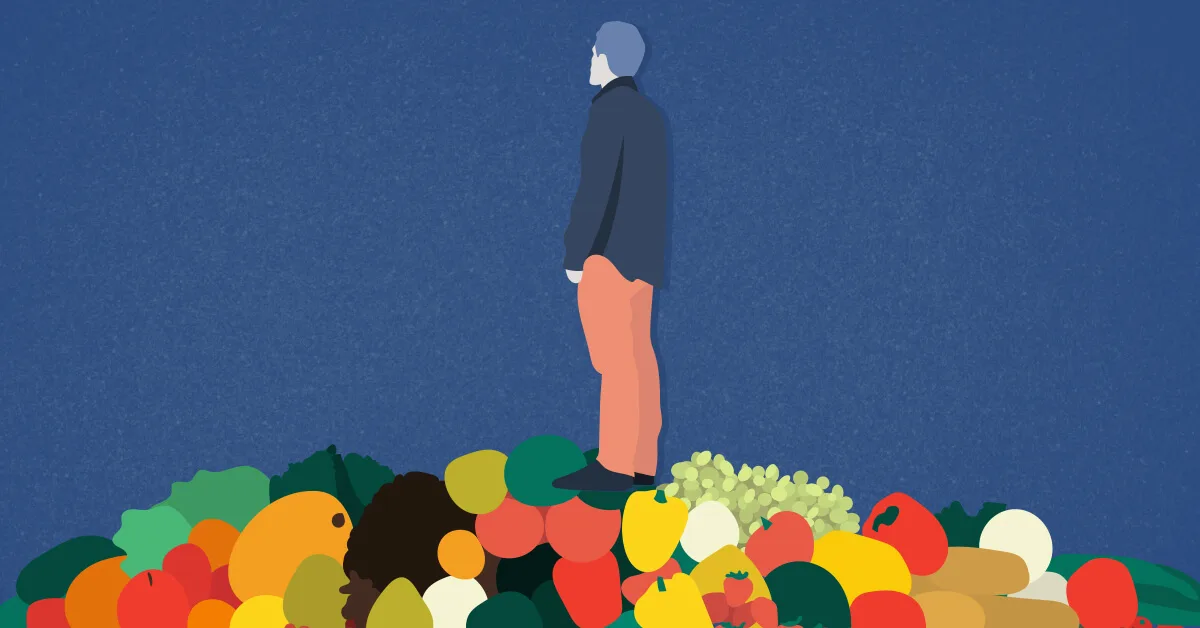
Because of physical and mental health issues, Damon Smith depends on SNAP to survive. His benefits are now at risk because of a new Trump administration rule.
Damon Smith remembers it like it was yesterday.
It was July 3, 2006. During a family gathering, Smith was following some people up a flight of stairs when the person at the top fell backward, causing a domino effect that ended with Smith suffering compound fractures in his leg.
“I broke my tibia, my fibia, and I dislocated my ankle,” Smith said. Five surgeries and many complications later, the 45-year-old still struggles to stand or walk for extended periods of time.
Smith, a resident of Washington, D.C., was also chronically homeless for over a decade before obtaining a housing voucher from the D.C. Department of Behavioral Health. In the early 2000s, he lost his driver’s license over unpaid parking tickets. He has also been diagnosed with Post Traumatic Stress Disorder (PTSD), bipolar II disorder, and anxiety.
These issues have conspired with other challenges (such as his lack of a post-graduate degree) to make it impossible for Smith, a former construction worker, to find and keep full-time work. They’ve also forced him to rely on the Supplemental Nutrition Assistance Program (SNAP), commonly known as food stamps, to survive.
Those benefits, however, are now at risk. Smith is one of 688,000 Americans who, under a new Trump administration rule tightening work requirements for SNAP beneficiaries, could lose access to food stamps that help prevent him from experiencing hunger.
“Callous and cruel intentions“
The proposed rule, which was finalized by the U.S. Department of Agriculture (USDA) in December, threatens the benefits of able-bodied adults between the ages of 18 and 49 who don’t have dependents. Currently, these individuals are only eligible to receive SNAP benefits for a maximum of three months during a 36-month period, unless they work or participate in a work training program for at least 20 hours per week.
But in order to allow for flexibility during economic downturns, states have been allowed to waive this time limit in individual counties where the 24-month average unemployment rate was at least 20 percent above the national average, or where there was a lack of jobs. Counties with unemployment rates as low as 2.5 percent have qualified for waivers under the current system.
Smith’s home of Washington D.C., which is treated as a county equivalent, had an unemployment rate of 5.3 percent as of December 2019, well above the 3.6 percent national rate.
Under the new rule, however, the minimum unemployment rate for a county to receive a waiver is 6 percent, making it more difficult for states to provide the waivers. The change is set to go into effect on April 1.
Tens of thousands of people logged public comments opposing the proposal. Bipartisan majorities in both houses of Congress also rejected adding work requirements to SNAP as part of the 2018 Farm Bill. Rep. Marcia L. Fudge (D-OH), chair of the House Agriculture Subcommittee on Nutrition, Oversight, and Department Operations, blasted the administration for what she called its “callous and cruel intentions.”
“This is an unacceptable escalation of the Administration’s war on working families, and it comes during a time when too many are forced to stretch already-thin budgets to make ends meet,” Fudge said. “Instead of considering hungry individuals and their unique struggles and needs, the Department has chosen to paint them with the broadest brush, demonizing them as lazy and undeserving.”
The rule, which is expected to save the government $5.5 billion over five years, is one of three Trump administration proposals designed to restrict access to food stamps. (The other two are expected to be finalized later this year.) If all three rules are implemented, 3.7 million people would lose their food stamp benefits, according to a recent study by the Urban Institute.
A helping hand
The USDA, which administers SNAP, says the waiver change is meant to encourage SNAP recipients to get jobs in an era of low unemployment, but hunger-relief advocates and policy experts believe it could actually have the opposite impact, making it harder for struggling Americans to find work.
“We need to encourage people by giving them a helping hand but not allowing it to become an indefinitely giving hand,” USDA Secretary Sonny Perdue said in a December 2019 statement. “This rule lays the groundwork for the expectation that able-bodied Americans re-enter the workforce where there are currently more job openings than people to fill them.”
The USDA has said there is federal funding for job training programs and other resources to help people find jobs, but in fiscal year 2016, the most recent full year for which data is available, SNAP’s Employment & Training programs only served about 200,000 people a month.
“That’s a fraction of the 700,000 people we think will lose benefits because of this rule,” said Robert Campbell, managing director of policy at Feeding America, a nonprofit hunger relief organization.
“This is an unacceptable escalation of the Administration’s war on working families, and it comes during a time when too many are forced to stretch already-thin budgets to make ends meet.”
Campbell and his organization oppose the rule. “There are proven ways to help people find work, and taking food away from individuals makes them no more ready to find a job or secure a job,” he said.
Giridhar G. Mallya, a senior policy officer at the health-focused philanthropy organization Robert Wood Johnson Foundation (RWJF), agreed.
“To do just about anything, including being present and effective at work, people can’t be hungry,” Mallya said. “So ultimately this policy, which is being argued as a way to get people to work, may have detrimental effects on people’s ability to work.”
“The poorest of the poor“
Anti-poverty and anti-hunger advocates say the focus on unemployment ignores the fact that people like Smith, who are being targeted by this rule, don’t necessarily have viable employment opportunities.
“The individuals who are subject to the three-month time limit are the poorest of the poor,” Campbell said. “It’s also a population that struggles with finding jobs … they often have less than a high school diploma, they face transportation challenges, and the logistics are not on their side for them to even attempt to meet this new harsh requirement that’s being put in place.”
Ninety-seven percent of these SNAP participants live in poverty, according to a March 2019 analysis conducted by Mathematica and funded by the RWJF.
The average income of these individuals is just 18 percent of the poverty line, or about $2,250 a year, and their average monthly SNAP benefits are about $165 per month, according to the left-leaning Center on Budget and Policy Priorities (CBPP).
Smith, who currently receives $194 in SNAP benefits per month, wants to find a job, but his physical and mental ailments and other barriers prevent him from being able to work full time. He currently participates in a newspaper vendor program organized by Street Sense Media, a D.C.-based company focused on ending homelessness. On days when he’s able to, he buys and flips copies of the Street Sense newspaper, but even on a good day, he’ll still only make about $20.
Smith has been trying to save that money to pay off his parking tickets because he knows that if he can get his license reinstated, he might have an easier time finding a job. But he worries that if he loses SNAP, he’ll have to use his “income” to feed himself, making it more difficult to get his license back.
Losing access to food stamps may also exacerbate his mental health issues, he said. “For me and many other people in vulnerable populations, it would definitely be a problem for us … it would mean depression and anxiety,” Smith said. “Not knowing what you’re going to eat, or how you’re going to eat throughout the day is a major, major distraction.”

Smith’s other alternatives would be to rely on donations or turn to local food banks and soup kitchens. In fact, many SNAP recipients who lose their benefits are likely to turn to food banks, only to find there won’t be enough resources for them.
”For every meal that we provide, SNAP provides nine or 10. We are kind of a back-up plan,” said Amy B. Hill, director of community engagement & advocacy for the Central Pennsylvania Food Bank, an affiliate of Feeding America.
The Central Pennsylvania Food Bank distributes food to a network of 1,400 partner agencies, such as soup kitchens and church pantries, across 27 counties in central Pennsylvania. Those partners serve over 135,000 people in need each month, including many SNAP recipients.
But the loss of SNAP benefits could put a strain on the food bank and others like it.
“Because SNAP is such a significant source of nutrition for people who are in some kind of difficult situation, if SNAP was to go away, there’s not enough charity in Pennsylvania or anywhere else to fill those gaps,” Hill said.
On a national scale, the gaps being created by the rule are enormous.
“When we see a loss of about a billion dollar of food assistance a year, that’s 625 million meals that will be lost from the tables of those individuals,” Campbell said. “That doesn’t make them any less hungry and in any less need of assistance.”
‘I didn’t fit their criteria’
Advocates are also concerned that many of these able-bodied adults—SNAP participants who are considered “nondisabled” because they do not receive federal disability benefits—may still have health issues that prevent them from working.
While SNAP’s rules for able-bodied adults without dependents provide exemptions to those who are certified as physically or mentally unfit for unemployment, others, like Smith, slip through the cracks and fail to receive those exemptions. Smith has applied for federal disability benefits twice, citing his physical and mental health issues, but was denied both times.
“They said I didn’t fit their criteria to be found mentally unfit or physically unfit for work,” Smith said.
His story is not an outlier. One study in Franklin County, Ohio found that as many as one-third of able-bodied adults enrolled in SNAP had at least one mental or physical issue, such as depression, post-traumatic stress disorder, or physical injuries that limited their ability to work.
‘A cascading impact’
The change could also hurt the local economies where these able-bodied adults live.
“SNAP is an incredibly important piece to local economies, in particular in rural areas, where there might not be as many food resource options,” said Campbell. “Every dollar that someone spends in a food retail setting supports many other things. It’s supporting the cashiers who are checking them out and the food supply chains that are getting that food to those retailers and grocery stores.”
In fiscal year 2017, SNAP beneficiaries redeemed about $63 billion in SNAP benefits for food purchases, generating business for both local convenience and grocery stores as well as national supermarkets and big-box stores. A 2010 USDA study found that every $1 in additional SNAP expenditures generated $1.79 of economic activity.
“In other words, every $5 in new SNAP benefits generates as much as $9 of economic activity,” the study read.
As Campbell pointed out, the new rule “will have a cascading impact on communities overall.”
Beyond these ripple effects, the rule also significantly undermines SNAP’s ability to respond if the economy were to suffer a downturn, Campbell said. “One of SNAP’s core strengths is its ability to respond to need almost immediately, so as unemployment rises, as individuals lose their jobs and their incomes go down, they’re able to apply for SNAP and generally get on it pretty quickly.”
“For me and many other people in vulnerable populations, it would definitely be a problem for us … it would mean depression and anxiety. Not knowing what you’re going to eat, or how you’re going to eat throughout the day is a major, major distraction.”
States will only be able to issue waivers when a county’s unemployment rate is on average 6 percent over the course of 24 months, so even if a county’s unemployment rate hits 8 or 9 percent, there might be a lag of several months before residents there become eligible for the waiver.
“If there is a downturn in the job market and unemployment is at 9 or 10 percent in a community for six months, or maybe even nine months, if the 24 month average still doesn’t meet that 6 percent threshold, then states won’t be able to provide these waivers,” Mallya said.
This could result in a significant lag in individuals’ abilities to qualify for SNAP, even when economic conditions worsen.
“We expect there to be a harder hit if and when the economy worsens,” Campbell said.
‘It’ll destroy them’
Advocates and lawmakers aren’t just speaking out—they’re also taking legal action. A coalition of 14 states, including Nevada and California, joined Washington, D.C., and New York City in filing a lawsuit against the Trump administration in January, seeking to block the rule.
On Feb. 4, the Trump administration asked a federal judge to allow it to deny the plaintiffs’ request for a preliminary injunction that would temporarily block the rule before it goes into effect in April. The court will hold a hearing on the preliminary injunction motion on March 5, according to The Hill.
Smith is also suing the Trump administration over the rule, and is being represented by the Legal Aid Society of the District of Columbia and Alston & Bird LLP.
Smith said he’s trying to stay positive while the lawsuit plays out. He’d like to go back to school and become a radiology technician, but he knows he won’t be able to do that if he’s experiencing hunger, or if he’s spending what little money he has on food.
If his lawsuit is unsuccessful and the rule goes into effect, that’s exactly what will happen: Smith will lose his SNAP benefits immediately and won’t be eligible to receive them again until April 2023.
He’s keenly aware of just how many other vulnerable Americans will suffer too, if the rule is implemented.
“It will be detrimental to them,” Smith said. “It’ll destroy them, and I think that’s not fair.”
Politics

Trump says he’s pro-worker. His record says otherwise.
During his time on the campaign trail, Donald Trump has sought to refashion his record and image as being a pro-worker candidate—one that wants to...

VIDEO: Hundreds show up in Scottsdale to support reproductive rights
@coppercourier Days after the Arizona Supreme Court ruled to enforce a long-dormant law that bans nearly all abortions, hundreds took part in a...
Local News

US court rejects a request by tribes to block $10B energy transmission project in Arizona
In Arizona, work was halted briefly in November amid pleas by tribes to review environmental approvals for the San Pedro Valley. ALBUQUERQUE, N.M....

What to know about Trump’s legal issues
Over the past year, former president Donald Trump has become the center of not one, not two, not three, but four criminal investigations, at both...




